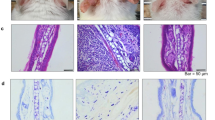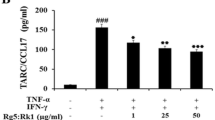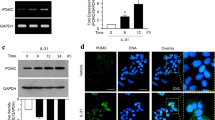Abstract
The alpha melanocyte stimulating hormone receptor (MC1R) is one of five G-protein coupled receptors belonging to the melanocortin subfamily, MC1R gene has been known to play a major role in regulating of fur color in mammals, and α-MSH and ACTH are endogenous nonselective agonists for MC1R. However, we found that MC1R was highly expressed in Raw 264.7 cells which were important inflammatory cells involved in the initiation of inflammatory responses. In addition, Cyclic AMP is not only a key molecule in the MC1R signal transduction pathway, but dampen innate immune-mediated responses. These intriguing biological results triggered the further conformation studies; it suggested that MC1R was very likely to be an important role in immunoregulation. In this study, we were to investigate the immunosuppressive effects of MC1R on inflammation in lipopolysaccharide (LPS) stimulated Raw 264.7 cells and LPS induced vivo 2-chloro-1,3,5-trinitrobenzene (TNCB)-induced atopic dermatitis (AD) model. The effects of the MC1R antagonist psoralen on pro-inflammatory cytokines and signaling pathways were analyzed by enzyme-linked immunosorbent assay, western blot, real-time fluorescence quantitative PCR and Histological analysis. Our results show a consistent and marked effect of high concentrations of MC1R antagonist psoralen increased the level of MC1R mRNA in Raw 264.7 cells by cumulative feedback regulation through preferential binding of MC1R. Moreover, as evidenced by inhibiting the LPS-induced TNF-α, IL-6 and enhancing the expression level of cyclic AMP protein in vitro. In vivo study it was also observed that psoralen promoted on histopathologic changes in the skin tissue of TNCB-induced AD mice. Taken together, our results suggest that MC1R decrease the inflammation in vitro and vivo, and might be a therapeutic signaling pathway to against inflammatory diseases.








Similar content being viewed by others
References
Leung DY, Boguniewicz M, Howell MD et al (2004) New insights into atopic dermatitis. J Clin Investig 113:651–657
Morar N, Willis-Owen SA, Moffatt MF, Cookson WO (2006) The genetics of atopic dermatitis. J Allergy Clin Immunol 118:24–34 quiz 35-36
Lubbe J (2003) Secondary infections in patients with atopic dermatitis. Am J Clin Dermatol 4:641–654
Nelson MP, Christmann BS, Werner JL (2011) IL-33 and M2a alveolar macrophages promote lung defense against the atypical fungal pathogen Pneumocystis murina. J Immunol 186:2372–2381
Liao CP, Lasbury SH, Durant Y et al (2009) Pneumocystis mediates over expression of anti zyme inhibitor resulting in increased polyamine levels and apoptosis in alveolar macrophages. J Biol Chem 284:8174–8184
Mosser DM, Edwards JP (2008) Exploring the full spectrum of macrophage activation. Nat Rev Immunol 8:958–969
Satoh H, Firestein GS, Billings PB, Harris JP, Keithley EM (2003) Proinflammatory cytokine expression in the endolymphatic sac during inner ear inflammation. J Assoc Res Otolaryngol 4:139–147
Taylor PR, Martine z-Pomares L, Stacey M, Lin HH, Brown GD, Gordon S (2005) Macrophage receptors and immune recognition. Annu Rev Immunol 23:901–944
Yingkui Y, Victor J, Victor JHruby, Chen Min (2009) Novel binding motif of ACTH analogues at the melanocortin receptors. Biochemistry 48(41):9775–9784
Kathleen G, Mountjoy L, Robbins S (1992) The cloning of a family of genes that encode the melanocotin receptor. J Sci 257:1248–1251
Schaffer JV, Bolognia JL (2001) The melanocortin-1 receptor: red hair and beyond. J Arch Dermatol 137:1447–1485
Liesel M, Fitz G, Jayne LF et al (2006) Effect of melantan, [Nle4.D-Phe7]-a-MSH. on melanin synthesis in humans with MC1R variant alleles. J Pept 27:388–394
D’Orazio JA, Nobuhisa T, Cui R et al (2006) Topical drug rescue strategy and skin protection based on the role of Mc1r in UV-inducedanning. Nature 443:340–344
Schaffler A, Scholmerich J, Buechler C (2006) The role of ‘adipotropins’ and the clinical importance of a potential hypothalamic–pituitary–adipose axis. Nat Clin Pract Endocrinol Metab 2:374–383
Steingrimsson E, Copeland NG, Jenkins NA (2004) Melanocytes and the microphthalmia transcription factor network. Annu Rev Genet 38:365–411
Wessells H, Gralnek D, Dorr R, Hruby VJ, Hadley ME, Levine N (2000) Effect of an alpha-melanocyte stimulating hormone analog on penile erection and sexual desire in men with organic erectile dysfunction. Urology 56:641–646
Jialing Y, Zhixue L (2008) High-Throughput Screening of crude antagonists of MC1R. J shang hai university (natural science) 14:216–220
Ho YS, Lai CS, Liu HI, Ho SY, Tai C, Pan MH et al (2007) Dihydrolipoic acid inhibits skin tumor promotion through anti-inflammation and anti-oxidation. Biochem Pharmacol 73:1786–1795
Tumurkhuu G, Koide N, Dagvadorj J et al (2008) The mechanism of development of acute lung injury in lethal endotoxic shock using alpha-galactosylceramide sensitization. Clin Exp Immunol 152:182–191
Mirzapoiazova T, Kolosova IA, Moreno L et al (2007) Suppression of endotoxin-induced inflammation by taxol. Eur Respir J 30:429–435
Satoh H, Firestein GS, Billings PB, Harris JP, Keithley EM (2003) Proinflammatory cytokine expression in the endolymphatic sac during inner ear inflammation. J Assoc Res Otolaryngol 4:139–147
Korhonen R, Lahti A, Kankaanranta H, Moilanen E (2005) Nitric oxide production and signaling in inflammation. Curr Drug Targets Inflamm Allergy 4:471–479
Libby P (2000) Coronary artery injury and the biology of atherosclerosis: inflammation, thrombosis, and stabilization. Am J Cardiol 86:3J–8J discussion 8 J-9 J
Joshua SY, Ann R, Feng C et al (2006) Statical amalysis of realtime PCR data. J BMC Bioinformatics 7(85):1471–2105
Huo Meixia, Chen Na, Chi Gefu et al (2012) Traditional medicine alpinetin inhibits the inflammatory response in Raw 264.7 cells and mouse models. Int Immunopharmacol 12:241–248
Giebelen IA, van Westerloo DJ, LaRosa GJ, de Vos AF, van der Poll T (2007) Local stimulation of alpha 7 cholinergic receptors inhibits LPS-induced TNF-alpha release in the mouse lung. Shock 28:700–703
Hodge DR, Hurt EM, Farrar WL (2005) The role of IL-6 and STAT3 in inflammation and cancer. Eur J Cancer 41:2502–2512
Leser HG, Gross V, Scheibenbogen C, Heinisch A, Salm R, Lausen M et al (1991) Elevation of serum interleukin-6 concentration precedes acute-phase response and reflects severity in acute pancreatitis. Gastroenterology 101:782–785
Remick DG, Bolgos GR, Siddiqui J, Shin J, Nemzek JA (2002) Six at six: interleukin-6 measured 6 h after the initiation of sepsis predicts mortality over 3 days. Shock 17:463–467
Marklund L, Moller MJ, Sandberg L, Andersson L (1996) A missense mutation in the gene for melanocyte-stimulating hormone receptor (MC1R) is associated with the chesnut coat color in horses. Mamm Genome 7:895–899
Kijas JMH, Wales R, Tornsten A, Chardon P, Moller M, Andersson L (1998) Melanocortin receptor 1 (MC1R) mutations and coat color in pigs. Genetics 150:1177–1185
Garcı′a-Borro′ n JC, Sa′ nchez-Laorden BL, Jime′ nez-Cervantes C (2005) Melanocortin-1 receptor structure and functional regulation. Pigment Cell Res 18:393–410
Mountjoy KG, Robbins LS, Mortrud MT, Cone RD (1992) The cloning of a family of genes that encode the melanocortin receptors. Science 257:1248–1251
April CS, Barsh GS (2007) Distinct pigmentary and melanocortin 1 receptor-dependent components of cutaneous defense against ultraviolet radiation. Plos Genet 3(1):e9
Steingrimsson E, Copeland NG, Jenkins NA (2004) Melanocytes and the microphthalmia transcription factor network. Annu Rev Genet 38:365–411
Cone RD (2005) Anatomy and regulation of the central melanocortin system. Nat Neurosci 8:571–578
Chhajlani V (1996) Distribution of cDNA for melanocortin receptor subtypes in human tissues. Biochem Mol Biol Int 38:73–80
Ni XP, Butler AA, Cone RD, Humphreys MH (2006) Central receptors mediating the cardiovascular actions of melanocyte stimulating hormones. J Hypertens 24:2239–2246
Cone RD, Lu D, Koppula S et al (1996) The melanocortin receptors: agonists, antagonists, and the hormonal control of pigmentation. Recent Prog Horm Res 51:287–317
Acknowledgments
This work was supported by grants from the National Natural Science Foundation of China (NSFC) (Nos. 30800807 and 31072097) and the Special Foundation for Postdoctor of China Ministry of Education (No. 20100471261).
Author information
Authors and Affiliations
Corresponding author
Additional information
Wei Chen and Jianping Li contributed equally to this study.
Rights and permissions
About this article
Cite this article
Chen, W., Li, J., Qu, H. et al. The melanocortin 1 receptor (MC1R) inhibits the inflammatory response in Raw 264.7 cells and atopic dermatitis (AD) mouse model. Mol Biol Rep 40, 1987–1996 (2013). https://doi.org/10.1007/s11033-012-2256-x
Received:
Accepted:
Published:
Issue Date:
DOI: https://doi.org/10.1007/s11033-012-2256-x




